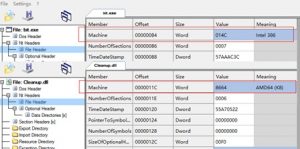【干货分享】Sandbox技术之DLL注入
我们要在Sandbox中观察恶意样本的行为,就需要在恶意样本的进程中注入我们自己的代码,然后通过这些代码产生监控日志。这是目前Sandbox中监控常用的做法之一,当然也有一些更底层的办法来的监控日志。今天主要介绍用户态下远程DLL注入方式,将监控代码注入到恶意样本进程中。这种实现相对简单通用,只要将监控代码编译为一个DLL,然后注入到恶意样本的进程中,就可以获取到监控行为日志。
Sandbox的minitor程序可以拆分为inject程序和monitor.dll模块,inject程序负责启动app并将monitor.dll注入到app中,而monitor.dll则负责具体的API监控工作。整个monitor大致的运行过程:
- inject程序启动后设置自己的权限;
- inject程序启动被监控app程序,以挂起方式启动,因为我们希望一开始就进行监控,所以需要先挂起;
- inject程序将DLL注入到app进程中;
- inject恢复app挂起的线程,让app运行;
设置注入程序权限
Inject需要debug权限来读写app进程空间,这里通过EnableDebugPriv函数来设置对应权限。EnableDebugPriv函数根据name来设定权限,调用的时候实参一般是SE_DEBUG_NAME,即给inject进程设置debug权限。
|
1 2 3 4 5 6 7 8 9 10 11 12 13 14 15 16 17 18 19 20 21 22 23 24 25 26 |
int EnableDebugPriv(const char* name) { HANDLE hToken; if (!OpenProcessToken(GetCurrentProcess(), TOKEN_ALL_ACCESS, &hToken)) { printf("OpenProcessToken Error\n"); return -8; } LUID luid; if (!LookupPrivilegeValue(NULL, name, &luid)) { printf("LookupPrivilegeValue Error\n"); return -9; } TOKEN_PRIVILEGES tokenPri; tokenPri.PrivilegeCount = 1; tokenPri.Privileges[0].Attributes = SE_PRIVILEGE_ENABLED; tokenPri.Privileges[0].Luid = luid; if (!AdjustTokenPrivileges(hToken, 0, &tokenPri, sizeof(TOKEN_PRIVILEGES), NULL, NULL)) { printf("AdjustTokenPrivileges Error!\n"); return -10; } return 0; } |
启动应用程序
以挂起方式创建app进程,注意参数CREATE_SUSPENDED,这样我们就可以在恶意软件执行前就完成监控初始化工作。然后再恢复app的主线程,让恶意样本继续运行。
|
1 2 3 4 5 6 7 8 9 10 11 12 13 14 15 16 17 18 19 |
void StartApp(DWORD *pid, DWORD *tid, LPSTR app) { if(pid == NULL || tid == NULL || app == NULL){ return; } STARTUPINFO sinfo; PROCESS_INFORMATION pinfo; ZeroMemory(&sinfo, sizeof(sinfo)); sinfo.cb = sizeof(sinfo); ZeroMemory(&pinfo, sizeof(pinfo)); CreateProcess(NULL, app, NULL, NULL, FALSE, CREATE_NEW_CONSOLE | CREATE_SUSPENDED, NULL, NULL, &sinfo, &pinfo); *pid = pinfo.dwProcessId; *tid = pinfo.dwThreadId; printf("Remote App Process ID:\t%d\n", *pid); printf("Remote App Thread ID:\t%d\n", *tid); } |
注入DLL
这一步将monitor.dll注入到我们创建的app进程中,采用创建远程线程的方式进行注入(CreateRemoteThread函数)。这里面需要注意的是,CreateRemoteThread 函数传递的实参中,指针地址必须是app进程中的地址,而不能是inject进程中的地址,因为inject中的指针指的地址在app进程中是无意义的。比如这里的pRemoteDllPath指针,是先在app进程中远程申请内存(VirtualAllocEx),然后将字符串写入远程内存中(WriteProcessMemory)。
|
1 2 3 4 5 6 7 8 9 10 11 12 13 14 15 16 17 18 19 20 21 22 23 24 25 26 27 28 29 30 31 32 33 34 35 36 37 38 39 40 41 42 43 44 45 46 47 48 |
int InjectDLL(DWORD dwRemoteProcessId, const char* dll) { HANDLE hRemoteProcess; if ((hRemoteProcess = OpenProcess(PROCESS_ALL_ACCESS, FALSE, dwRemoteProcessId)) == NULL){ printf("Error Code:%d\n",GetLastError()); return -2; } LPVOID pRemoteDllPath = VirtualAllocEx(hRemoteProcess, NULL, strlen(dll) + 1, MEM_COMMIT, PAGE_READWRITE); if (pRemoteDllPath == NULL){ printf("VirtualAllocEx Error\n"); return -3; } SIZE_T Size; if (WriteProcessMemory(hRemoteProcess, pRemoteDllPath, dll, strlen(dll) +1, &Size) == 0) { printf("WriteProcessMemory Error\n"); return -4; } LPTHREAD_START_ROUTINE pLoadLibrary = (LPTHREAD_START_ROUTINE)GetProcAddress(GetModuleHandle(TEXT("kernel32.dll")), "LoadLibraryA"); if (pLoadLibrary == NULL) { printf("GetProcAddress Error\n"); return -5; } DWORD dwThreadId; HANDLE hThread; if ((hThread = CreateRemoteThread(hRemoteProcess, NULL, 0, pLoadLibrary, pRemoteDllPath, 0, &dwThreadId)) == NULL) { printf("CreateRemoteThread Error\n"); return -6; } else { WaitForSingleObject(hThread, INFINITE); printf("Remote DLL Thread ID:\t%d\n", dwThreadId); printf("Inject is done.\n"); } if (VirtualFreeEx(hRemoteProcess, pRemoteDllPath, 0, MEM_RELEASE) == 0) { printf("VitualFreeEx Error\n"); return -7; } if (hThread != NULL) CloseHandle(hThread); if (hRemoteProcess != NULL) CloseHandle(hRemoteProcess); return 0; } |
恢复app线程
远程注入minitor.dll之后,Sandbox的监控环境就绪,下面可以恢复app的主线程,让app运行恶意样本了。
|
1 2 3 4 5 6 7 |
void ResumeRemoteThread(DWORD tid) { printf("Resume Remote Thread: %d\n", tid); HANDLE thread_handle = OpenThread(THREAD_ALL_ACCESS, FALSE, tid); ResumeThread(thread_handle); CloseHandle(thread_handle); } |
获取app程序路径
传递给Sandbox的是一个恶意样本,inject程序需要根据恶意样本的文件类型(可以文件后缀识别,也可以文件内容magic识别等),自动查找Sandbox中对应的应用程序路径。一般就是搜索程序目录或者注册表,比如搜索ProgramFiles、ProgramFiles(x86)、System32、SysWOW64等路径,查到对应的app路径就行。本文暂时省略这块,以winword.exe作为固定测试对象跑一下效果。
|
1 2 3 4 5 6 7 8 9 10 11 |
char* GetAppCMD(char* buffer, const char* sample) { //TODO: //1、Get File Type From Name or Content. //2、Get APP path by File Type(ProgramFiles、ProgramFiles(x86)、System32、SysWOW64). //Only4Test char* app = "C:\\Program Files\\Microsoft Office\\Office15\\WINWORD.EXE"; snprintf((char*)buffer, sizeof(buffer), "%s %s", app, sample); return buffer; } |
主函数
写一个简单的测试函数,指定monitor.dll和sample,然后运行样本并执行注入。
|
1 2 3 4 5 6 7 8 9 10 11 12 13 14 15 16 17 18 |
int main(void) { const char* monitor = "C:\\users\\ken\\downloads\\monitor.dll"; const char* sample = "C:\\users\\ken\\downloads\\sample.docx"; printf("Current Inject PID: %d\n", GetCurrentProcessId()); char buffer[512]; LPSTR cmd = GetAppCMD(buffer, sample); EnableDebugPriv(SE_DEBUG_NAME); DWORD dwRemoteProcessId, dwRemoteThreadId; StartApp(&dwRemoteProcessId, &dwRemoteThreadId, cmd); InjectDLL(dwRemoteProcessId, monitor); ResumeRemoteThread(dwRemoteThreadId); return 0; } |
通过以上代码我们大致知道了整个monitor程序的运行过程,下面看一下运行效果,图1是运行的打印信息:
- inject.exe的PID为14960;
- inject.exe创建winword.exe进程并加载恶意样本,winword.exe进程ID为11216,主线程ID为15496;
- inject.exe注入monitor.dll模块到winword.exe进程中,远程DLL线程ID为14204;
- 恢复winword.exe主线程15496;
我们可以通过一些进程监控软件看看app进程的运行过程是否符合预期,下面是监控事件截图(注:为了好展示去掉了部分无关事件),我们可以看到monitor.dll已经注入到winword.exe进程中了。
到这里我们完成了一个简单的注入器(除了windows编译环境,以上代码可以在ubuntu+ mingw环境下编译测试)。这个注入器可以运行app,然后将DLL注入到app中。还有几个遗留问题需要考虑:
- 对于windows平台,目前有x86和x64,这样我们需要判断对应样本(一般PE需要判断)属于哪个平台,然后启动对应版本的inject才行。对于PE文件我们可以通过IMAGE_DOS_HEADER和IMAGE_NT_HEADERS来判断。如下图,IMAGE_FILE_HEADER中的machine标记,0x014c表示高于i386的CPU,0x8664表示AMD64的CPU。
 2. 那monitor.dll如何监控app的运行呢?最常用的实现方法之一是使用API HOOK技术,在monitor.dll中对app的系统调用进行hook,这样就可以记录app的所有系统交互行为了。我们后面会继续介绍minitor.dll的实现过程,以完成一个完整的Sandbox行为分析系统。
2. 那monitor.dll如何监控app的运行呢?最常用的实现方法之一是使用API HOOK技术,在monitor.dll中对app的系统调用进行hook,这样就可以记录app的所有系统交互行为了。我们后面会继续介绍minitor.dll的实现过程,以完成一个完整的Sandbox行为分析系统。
如果您需要了解更多内容,可以
加入QQ群:570982169、486207500
直接询问:010-68438880-8669

